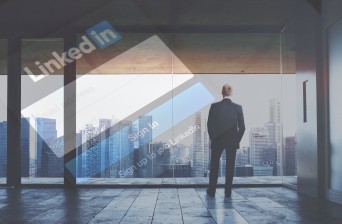LinkedIn As A Branding Tool: How Brands Can Reach Their Full Potential
How can your brand become more visible within LinkedIn?
Think About Your Audience
The most important element in branding, marketing, and PR is your audience. Who are you targeting? Which people will receive your messages when you start broadcasting on LinkedIn?
When it comes to social media platforms and branding Twitter is best comparable to a billboard, you put your message out there and you hope people will see it. Facebook is more targeted, like a magazine on a certain topic: it might get you attention, but people might flip through it quickly. LinkedIn however is a bit different. On LinkedIn you are targeting a very specific group of people with specific expectations. They see LinkedIn as a human connection tool, which means, they won’t be responsive at all to a message from a brand, unless they trust the brand. However, they might respond to a message from a person, especially if they know that person. It’s like the local business club. People trust what is said, and if the trust fails, they won’t look at the source again. So both as a brand and a person you want to built trust.
This means that when using branding for LinkedIn you have to keep one thing in mind: do not use it as a billboard. Make it personal, be trustworthy and make it worth the time of those you are targeting. If not, they won’t give you a second glance.
Where Brands Go Wrong On LinkedIn
Unfortunately I still see too many brands (and people) making this mistake on LinkedIn and treating the service as a billboard. They constantly post links to their own website in groups, they send out mass e-mails to their LinkedIn connections talking about their ‘great product’ and they keep adding new connections without even looking at who they are.
Wrong!
If you really want to use LinkedIn as a branding tool and make it work, you need to think first. Think about your audience and think about what you can give them to make them better.
Branding Using LinkedIn
In essence you can say that there are two ways you can use LinkedIn for branding: branding as a business (your company) and personal branding, making sure you look good for new job options or business opportunities (more on this topic in tomorrow’s post).
Findability
One really important thing to keep in mind when it comes to branding: search. LinkedIn’s search functionality is a much used functionality. People use LinkedIn search for several different reasons – they’re looking for jobs, for pages, and for people.
You want your brand to be found when people start searching. That is the first step of branding.
Advanced search on LinkedIn is especially interesting. Here people can filter down to different levels, from people and jobs, to posts, groups, and regions.
The essence here is that in every tactic you use (some of which are being discussed below), you must keep in mind how findable you can be for the different elements of search in LinkedIn. Use the right keywords, create the right content, and make the right connections. (A nice additional benefit for this is that you will also start ranking better in search engines!)
Branding For Businesses
With a little work, your brand can become more visible within LinkedIn. It all starts with figuring out what you want to be visible for. Is it to attract new personnel? To show the world how knowledgeable your company is? Or another reason?
This determines which of the tactics you will use. As always, it’s strategy before tactic.
Here are some branding tools LinkedIn provides to help brands reach their full potential.
Company Page
The LinkedIn Company page has seen a big make over in the past few years. Where before it was just showing yourself, whereas nowadays it’s much more. One thing to keep an eye on is the information you share and how you look.
There is the standard information you have to fill in. Make sure you fill in all parts. When doing this, think about what people might be searching for (especially when deciding on the specialties)!
Also be sure to use the right logo (think about the sizes) and be sure to create a beautiful header. Just like on Facebook and Google+ as a business you now have the option to showcase who you are using a banner. Try changing these banners around and adapt them to current situations. See for example how brands like Apple use it:
Your company page will also show your updates. Many brands still make the mistake of only sharing company news. Here you have the possibility to show how knowledgeable you are, so make sure to combine the news about your company with interesting (relevant!) information from other sources as well.
Career Pages
When trying to be a “cool” company, careers are important. Even if you aren’t looking for new staff, those checking out your LinkedIn Page will have to be impressed.
If a company takes care of its employees it after all is much more interesting for business as well. The career tabs again can be nicely designed and you can add valuable information to it, like for example videos. Again, take a look at how Apple does it:
Showcase Pages
Showcase Pages are so-called “niche pages” that are directly connected to a company page. These pages can be followed separately from the company page, which gives you the opportunity to segment for the different types of audiences you serve.
One example of a company that has been very active on company pages is Microsoft, which made pages for different products.
You can create up to 10 showcase pages. With that comes a nice set of analytics that will show you engagement, trends, and demographics of your followers.
Groups
Millions of LinkedIn Groups have been created, but lots of them honestly aren’t that interesting, simply because businesses set it up and then either leave it as it is, or use it as a billboard: spamming the crap out of the members.
As a business you can set up a group and it can work, as long as you do it properly: don’t overdo it, be very targeted on the topic (don’t create a group for your business, but for a topic that relate to your business), and make sure that within the group you act as a thought leader – show what you know!
Advertising
Like all social platforms, LinkedIn also offers advertising opportunities. These are still quite interesting because they are affordable and you can target reasonably good. You can for example try to get certain group members to follow your company or services, or even better, you can ask them to recommend you or share your page.
Standing Out: Have A Strategy
Finally, when it comes to branding your business on LinkedIn, the most essential part is your strategy. Think about how you want to be seen, think about what your potential audience wants to see, and create content around that. Use your employees in this: have them publish articles, have them “present” you, and make sure you tell your story.

